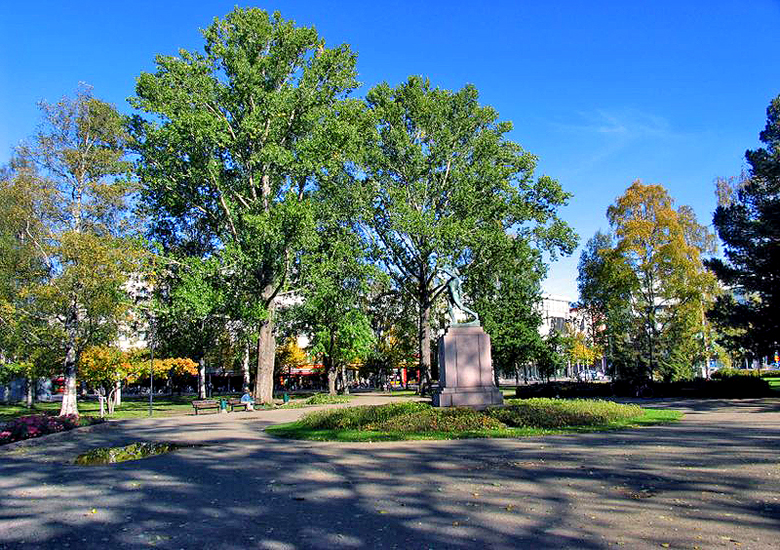Joensuu , the second largest city in Eastern Finland and the capital of North Karelia is located at the outfall of the river Pielisjoki in the Saimaa lake system. The city center is on the right bank of the river around the main square, where the town hall, museum, hotels and restaurants, shops. Joensuu has square town plan. From the main square of the bridge leading across the island Ilosaari to the train station. Understand : Joensuu is – as the name of the place translates – at the mouth of a river entering a lake. It is one of the fastest growing centres in Eastern Finland, with a university that educates a constant stream of new students from all over the country. There are also a number of foreigners doing their study exchange or post-graduate studies here.
Access : Coordinates:62.6, 29.75 / By plane : Many daily flights from Helsinki provided by Finncomm Airlines and Finnair. Estonian Air has also direct flights from Tallinn . A bus runs between the airport and town (the university and downtown) before and after each flight. The bus takes 10 minutes and costs €5. There are also taxis at the airport.
By train : Direct connection from Helsinki via Lappeenranta, several trains a day. Travel time is about 5 hours. If coming from Russia, transfer at Kouvola. Station is small, open only during the day. Located on Railway square on the left bank of the River.
By bus : From Helsinki several times a day on the road for about 7 hours, there is a night bus almost every day. See Matkahuolto. Bus station is located on Railway square.
By car : If you’re driving from Russia and cross the border at Nuijamaa in Lappeenranta, turn on the main road 6, taking you to Joensuu. If you cross at Niirala, simply follow the main road 9 until it joins the main road 6. Main route 6 goes from Helsinki via Lappeenranta and Kouvola in Joensuu and further Nurmes and Kajaani.
Attractions :
Carelicum, Koskikatu 5 . The North Karelian Museum displays a wide range of stuff from Karelian folklore dresses to maps and photographs of places nowadays forgotten behind the Russian border. If you have made the effort to go to Joensuu, it is well worth a visit. If you are a student of Finnish Culture (e.G. in Helsinki University), you might get in for free, try! Open daily, Mo-Fr 10 – 17 Sa-Su 11 – 16, except on national holidays.
2 Joensuu Bunker Museum (Joensuun bunkkerimuseo) (in Marjala district, 7 km towards Kuopio). Tue-Sun 11AM-5PM. As part of the Salpa-line protecting Finland from the threat of Russia during WW2 the museum displays several models of concrete bunkers fully equipped with original guns and gear. A bizarre but worthwhile visit. During summer some local history students will hang around geared up as soldiers serving tea and are willing to answer all your questions. Open only during the summer.
3 City Hall (Kaupungintalo). on the main square in the Art Nouveau style by the famous Finnish architect Eliel Saarinen. Saarinen is also the author of the Helsinki Central Railway Station (1909), and they resemble each other remarkably. The theater of the city also functions in the same building.
4 Joensuu Arena, Mehtimaenaukio 2. Joensuu Arena, the largest wooden building in Finland offers a magnificent setting for various types of events in Joensuu. The Arena is suitable venue for a wide variety of events from fairs to exhibitions, concerts and from small-scale meeting to large confrerences. In sports use, the Arena is suited for football, Finnish baseball, athletics, boxing, climbing and many indoor sports.
5 City Center (Keskusta). Wooden 19th century houses close to the Pielisjoki river. Some other remains of the wooden Joensuu remain here and there, but the old town as it was is now mainly lost due to construction speculation in the 1960s up to present. The center anyhow follows the town plan that was made in 1848. Streets were made wide to prevent fire in a wooden town, and the trees in the streets are birch for the same reason, for example in Kirkkokatu (Church St.) that has a church in both ends, Greek Orthodox and Lutheran. Otherwise the centre is a rather ugly grid system post war concrete collection of houses with the typical shops and bars and restaurants you will find in any Finnish city. Most important modern buildings are the new library and Metla building in the university campus (There is a cafe inside).
Activities :
Events
1 Ilosaarirock. The Ilosaarirock Festival is an annual rock festival held in Joensuu on the second weekend of July. Founded in 1971, Ilosaarirock is the second oldest rock festival in Finland still active, and one of the oldest in Europe. Ilosaarirock gathers about 21,000 daily visitors and has been sold out in advance every year since 1998.
Ilovaarirock: 7 July 2018. Ilovaarirock is a shadow festival of Ilosaarirock (date needs updating)
Rokumentti Rock Film Festival. An annual film festival held in November.
Go next : Ski resort and national park of Koli north of the city. You can reach Koli ski resort by bus of Matkahuolto.

